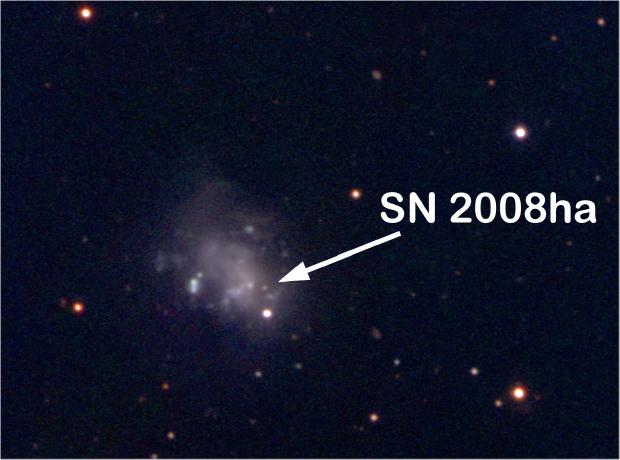After running out of fuel, the core of such a star collapses and forms a neutron star or a black hole. At the same time, the outer layers are ejected at high velocity (up to 10% of the speed of light) and shine as brightly as billions of stars together.
To provide some perspective, the total energy suddenly released by such a supernova exceeds the total energy release by our Sun to-date; and also in the next 10 billion years.
However, some core-collapse supernovae are up to 100 times less energetic and luminous than expected. These low-power explosions normally show the presence of hydrogen gas, but a new event, supernova SN 2008ha, in the galaxy UGC 12682, is the first dim supernova in which no hydrogen could be detected.

CLICK IMAGE ABOVE FOR FULL SIZE. Color image of supernova SN 2008ha taken on 2008 December 30 at Calar Alto Observatory, with the Zeiss 2.2m Telescope and camera CAFOS. It is a composite of the B, V and R bands. The SN is the faint reddish dot marked with an arrow. The quite irregular shape of the galaxy UGC 12682, that hosts the supernova, is seen at the center of the image. Credit: Stefan Taubenberger, Max Planck Institut for Astrophysics.
This research has been performed by an international team lead by the Italian astronomer Stefano Valenti (Queen's University in Belfast, United Kingdom), including scientists from Max Planck Institute for Astrophysics (Germany), the National Institute for Astrophysics (Italy), and various other institutions. The results are based on data gathered at Calar Alto Observatory (Andalusia, Spain), the Telescopio Nazionale Galileo (TNG), Nordic Optical Telescope (NOT) and Liverpool Telescope (all in Canary Islands, Spain), the Copernico Telescope (Asiago Observatory, Italy), and other smaller observational facilities.
Taken together, the dimness and lack of hydrogen leave room for two scenarios for the origin of SN 2008ha:
(1) The progenitor star may have been a moderately massive star in a binary system, which lost its outer layers through the interaction with the companion.
(2) The explosion may be due to a very massive star which shed its envelope through stellar winds and formed a black hole upon core collapse.
If the latter scenario should prove to be correct, SN 2008ha may be of particular importance in our understanding of the connection between supernovae and a group of gamma-ray bursts. The tale of SN 2008ha is one more step in an ongoing research program whose goal is to unveil the secrets of these cosmic explosions.
Article: S. Valenti et al., Nature 459, 674-677 (4 June 2009)





Comments